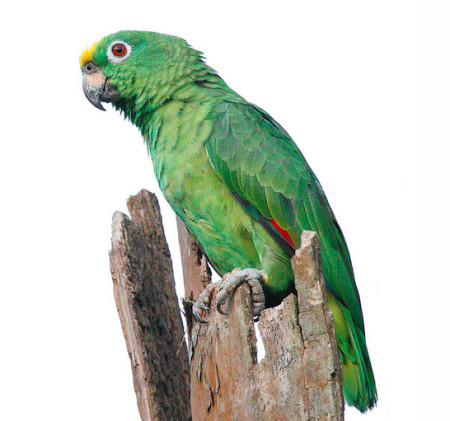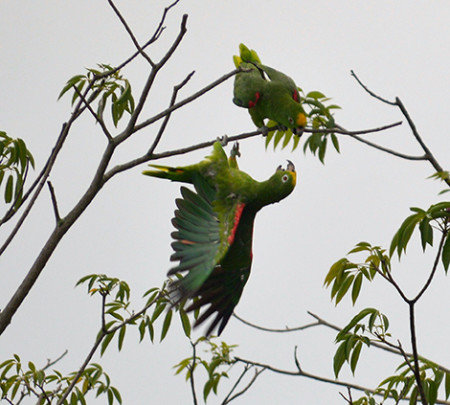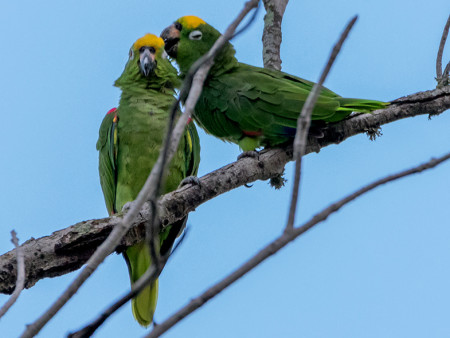
Many comic book characters we know and love today can be identified by their signature symbols. In the blink of an eye we can recognize the S of Superman’s shield or the beaming light of the Batman logo when Gotham City needs the Dark Knight to fight its villains. Likewise, when many Trinidadians see a parrot with bright yellow on the head they immediately identify it using the local name, “Venez” Parrot. But few people know that this bird belongs to a superspecies group of Amazon Parrots (genus Amazona) comprising 11 subspecies. A superspecies is a species complex of closely related, very similar species that are often difficult to distinguish. The subspecies are categorized into three groups: 1) Yellow-crowned or ochrocephala 2) Yellow-naped or auropalliata and 3) Yellow-headed or oratrix.
Amazona ochrocephala ochrocephala, the Yellow-crowned Parrot, known locally as the Yellow-crowned Amazon (or Venez Parrot) found on Trinidad belongs to the – you guessed it – “Ochrocephala” group. It was possibly introduced from Venezuela or Guyana but its distribution extends into Colombia, Brazil, Suriname and French Guiana. This medium-sized Amazon weighs about 500 grams with primarily green plumage, a yellow forecrown and white eye-ring. Look carefully and you will see that the bend of the wing and base of the tail are both red. These traits are used to distinguish it from the ever present and ever noisy Orange-winged Parrots (Amazona amazonica). If you can’t get an up-close look at the parrot listen for its call which is a distinctive mellow, rolling bow-wow; this is in contrast to the shrill kik-kik…kik-kik calls of the Orange-winged Parrots.
Yellow-crowned:
Orange-winged:
Like most other parrots, Yellow-crowned Amazons are monogamous and prefer to nest in hollow trees or palms. While other Amazons choose their nesting cavities based on tree species, cavity height from the ground and cavity entrance size, Yellow-crowned Amazons tend not to have a preference for a specific tree species but do require trees in good condition. Because pairs maintain their nesting territories throughout the year, things can get really loud if a bird or pair tries to take over another pair’s nest or even if a neighbour oversteps his boundary. Yellow-crowned Amazons are very aggressive and coordinated in defending their nests. The nesting pair will vocalize while perched next to each other or physically attack an intruder by lunging with beak open and wings extended.
A human archnemesis

If Yellow-crowned Parrots and their superspecies are superheroes of the bird world, then poaching of juveniles can be considered the population’s kryptonite. Fledglings over 40 days old are commonly taken from the wild though some poachers remove nestlings from the cavity when they are as young as three days old. Removing young birds from the wild is as bad for the population as it is for the individual birds. The young parrots are taken before they have reached sexual maturity and therefore, the current breeding pool of adults is not being expanded or replaced.
One reason Yellow-crowned Amazons are so popular for the pet trade is their ability to mimic human speech quickly. Because they are so desirable, some poachers in Central America dye the forecrown feathers of Red-lored Amazons (A. autumnalis) and Brown-throated Parakeets (Aratinnga pertinax) yellow and sell them as Yellow-crowneds to unsuspecting customers. Currently, Yellow-crowned Parrots are considered Least Concern by IUCN due to their wide geographic distribution and estimated healthy population size. However, the combination of habitat loss, their low reproductive rate, and poaching for the pet trade remains a major concern.
Vocalizations: an unsung hero

Even I would admit that hearing a parrot “talk” is very entertaining and amusing. However in the wild they use their own dialect with each other and their communication is not limited to repeating the calls of one or a few parrots. Yellow-crowned Amazons use syntax to arrange the structure of calls including those used in territorial disputes. It is plausible that by using syntax, communication among parrots is more flexible than we think. In addition, dialect through duets is used to woo potential mates and successfully reproduce. Males and females have sex-specific notes. These serve to tell the caller’s sex, availability to pair (i.e., spoken for or not) and to facilitate communication with multiple interested parrots . Yes, all is fair in love and war, even for parrots.
Other vocalizations, like contact calls, are used to maintain order within flocks to achieve common goals such as finding food or avoiding predators. Just imagine how little justice would get served if the members of the Justice League were unable to create a strategy to fight their enemies because they didn’t understand each other! Interestingly contact calls may also serve to ascertain a parrot’s regional identity. A survey of 16 Amazon roosting sites in North and South Costa Rica, 18 miles apart, revealed that each region had a distinct type of call. Researchers found that neighbouring roosts within a region shared a common call type and in each roost a single call type was recorded resulting in the mosaic pattern typical of vocal dialects in humans.
When Yellow-crowned Amazons are kept as pets and taught to repeat silly phrases, we undermine so much of their intelligence and even their identity. Out of the cage they speak their own language, one that takes years to develop and runs much deeper than “Hello” or “Who’s a pretty bird?” In order for this beautiful, complex superspecies to thrive in the wild, we all need to be local superheroes and take a stand against wildlife poaching.
How can you help parrots in the wild?
The Blue and Gold Project recently launched their fundraising campaign to protect the Blue and Gold Macaw in Trinidad. This large, charismatic bird was extirpated from the island in the 1960s. A reintroduction program began in 1999, and after several releases, there is a small, stable population with documented breeding success. The Blue and Gold Project is raising funds to host local capacity building workshops to educate community members about wild macaws and the pet trade, monitor the illegal trade of macaws, and conduct much-needed research on the wild reintroduced population. Please donate today!
